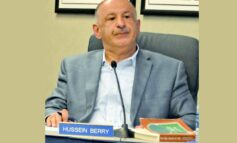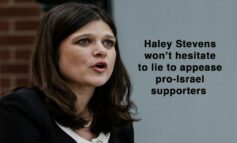The June 1982 Israeli invasion of Lebanon that led to the occupation of its capital Beirut again exposed a glaring lack of Arab opinion in America’s mainstream media, and it became a breaking point later that year for three individuals from different worlds who wanted to make a change. The biased reporting on Arab issues that continued to dominate world affairs and accompanying twisted, distorted portrayals of Arabs had become too damaging and too much to bear, and they knew something needed to be done.
Myself, at the time a vice president of an export/import company based in Michigan and doing business mainly in the Middle East with an engineering background and no knowledge whatsoever in journalism; an old friend, a Lebanese national political writer/commentator with no knowledge of American politics, media and culture with virtually no English skills, and a head nurse at St. John Hospital whose inclusion was at first purely coincidental, set out to change the media landscape for Arab Americans, especially in Metro Detroit, for decades to come.
The first Arab American weekly bilingual newspaper debuted on January 23, 1985. Marianna Kay Siblani, the latter member of the group, became instrumental in planning, implementing and producing the publication, first known as Sada Alwatan (The Nation’s Echo) which became known later in English as The Arab American News.
She was very attracted to the Arabic culture and language, amazed by the desert and the powerful message of Islam, with very little knowledge of Arab politics and in particular the Palestinian dilemma. She was fascinated with the Islamic Call to Prayer (Azan). She was extremely smart and thirsty for knowledge. The more she knew, the more she became involved. The injustices brought upon the Palestinians and their senseless suffering dominated her thinking and boggled her mind. She couldn’t understand nor could she accept the foreign policy of her nation that ran contrary to everything she was taught that America stands for. What made her angrier and perhaps more determined was the absence of Arab perspective on the issue and the lack of engagement by Arab Americans to gather their strength and present their case to the American public.
Kay was a white, working class American single mother who hadn’t been outside the U.S., or further than Beaver Dam, Kentucky where her grandmother resided in a rural area, for that matter. She was on a mission and nothing was going to stop her determination to complete what the trio soon came to realize would be an extremely complicated and difficult adventure.
Soon, I became the translator between her and Sobhi Ghandour, the aforementioned old friend and editor of the Arabic section of Sada Alwatan. She threw herself into the job, developing an intense desire to learn everything she could about the Arab world and Arab communities, along with their tradition, culture and religion.
The takeoff was extremely complicated, costly and time consuming. The fine details of bringing equipment and staff to launch the project were even harder and more expensive than originally predicted. But Kay was determined that it should and must be done.
Eventually, I had to quit my good paying job to manage the paper full time. Soon, she had to also quit her nursing job to attend to the English section of the paper and help me manage this seemingly impossible task. Through the challenges, she always remained determined and optimistic that the community would soon realize the importance of our mission and would join us in our efforts.
The first year flew by and the trio became a duo. Sobhi Ghandour departed, returning to Lebanon and then to Washington to establish what is currently known as Alhewar Center in the nation’s capital.
Kay and I continued with the help of a few dedicated, underpaid and overworked staff members under an extremely tight budget that continued to diminish, while the financial help that we were waiting for to arrive from the community was beginning to show itself as a mirage.
On the second anniversary of The Arab American News at the end of February 1987, as we put the special anniversary issue to bed around 3 a.m., Kay was following me with the keylines of the English section to a printing facility in Detroit. As she crossed the side street near our office on Michigan Avenue, a drunk driver slammed into her, throwing her meters away before a street sign forced the driver’s car to stop, sparing her life.
She was taken to Oakwood Hospital by ambulance that morning, begging me not to leave her side before falling unconscious. The keylines were scattered on the sidewalk and in the middle of the street. Attending to her situation at the emergency room she looked me in the eye, telling me to leave and take the paper to the printer: “It needs to be out on time!”

|
| Kay Siblani |
She had just finished writing the editorial for that issue; the headline read: ‘Challenges and Pride.’
Challenges were understating the state of her health and the financial hole that we were digging for both of us. Later a collapsed lung due to the accident helped physicians at Oakwood Hospital discover a tumor in her right lung known as Lung Carcinoma.
Two months later her right lung was removed at St. John Hospital and she underwent radiation treatment. During her recovery at both hospitals Kay insisted to write and edit the English section of the paper; we obliged and brought the keylines to her hospital bed week after week.
Meanwhile the financial hole got deeper, with no income for both of us and few signs of hope. Very little ad income came in, and it was not enough to pay the bills and the payroll.
Soon, we had to write literally by candlelight after our electricity was shut due to non-payments. Meanwhile the boiling Middle East was presenting us with more challenges and thus further responsibilities to maintain the paper and to respond to ever-increasing demands for information, opinions and answering more inquiries from American national and local mainstream media, as well as international media.
In 1990, as we were in the middle of the U.S.-led coalition war on Iraq and the ultimate demand of media coverage of that unprecedented event; one that reflected on our community as well as on the Arab world, Kay lost her balance as she was walking and fell to the ground in her house. She was rushed to St. John Hospital and later was diagnosed with a brain tumor on the stem. After she was diagnosed at St. John Hospital we were told that local area hospitals are not capable of removing such tumors successfully.
On the verge of bankruptcy and marching toward financial ruin with no health insurance, we went home crying. But, the mighty Kay didn’t give up. She put her nursing hat on and searched for a solution. The Mayo Clinic can do it, she said.
We borrowed some money to pay for her health insurance with hospital coverage (It was easier then). We packed our suitcases and of course the keylines of The Arab American News, and drove to Minnesota. There at the Mayo Clinic she underwent a one-of-a-kind brain surgery that lasted twenty-two hours.
In the recovery room as we were waiting for her to wake up, a warning came down from her chief surgeon that permanent damage to her sight, hearing or speech would be a possible consequence of such a complicated and rare surgery. She was fully aware of the consequences and the risks. A few minutes after she opened her eyes, she asked, “Did you deliver the paper to the printer before you came?”
Her incredible commitment has always shined through, and always put mine to shame. Her determination to make a success of this paper was unmatched, even by me.
The ride after that became very bumpy and the financial obstacles negatively affected our personal relations, but never our friendship, as well as our determination to rescue the paper.
Years went by trying to make a success out of The Arab American News while working other jobs to make ends meet. She started her own public relations firm and dove into providing healthcare solutions for Muslims while working as hard as ever to continue helping me to publish the paper week after week. Eventually, I found a day job working for the Arab American and Chaldean Council in Lathrup Village. Through it all, she never wavered in her commitment to the Arab and Muslim community. Her love of the culture and her admiration of Islam continued to grow.
She helped set up the local office of the Council on American-Islamic Relations (CAIR-MI) and even managed it for a while during its most difficult times, after the devastating terrorist attacks of September 11, helping to protect a community dealing with the unprecedented challenges of the resulting backlash. She also helped the Muslim Observer newspaper launch in the late-90’s.
In the mid-90’s she wrote a first-of-its-kind, comprehensive manual on how to treat Muslim patients in American hospitals. She held several seminars on Islam and the Muslim patient including, ‘Impact of Religion and Culture on Health Care Delivery,’ attended by medical staff of national and local healthcare outlets and hospitals.
Two years ago, she was faced with another vicious wave of cancer that became especially aggressive in the last few months. She fought with all her strength, and with our and her family’s support, and never surrendered until the last two weeks when she was told by the best medical doctors in the country that “she was at the end of the line.”
Her will was never broken, even though she admitted defeat this time.
Her last few words on New Year’s Eve were directed toward me while I was visiting her for the last time. These words, I will keep to myself and remember forever. Her family told me she never spoke after that night.
She waited till everyone celebrated the New Year before she bid all of us a farewell. Kay is that kind of a lady.
Quietly, she passed away on January 1, 2013 at 6:15 p.m.
She will always be remembered here, and everywhere else she walked.
Goodbye, my dear friend. You are gone but never forgotten.
Thank you!
The Arab American News extends its thanks to the many people who offered condolences on the passing of the paper’s longtime executive editor, Kay Siblani, via phone, email, and Facebook. Thank you for all of your support and heartfelt messages; we apologize for not printing all of them because it would be impossible.
Marianna Kay Siblani is survived by her mother Anna Leota Kendall, her daughter Michelle, her brothers Kenny and Keith, her sister Kathy, and three grandchildren Brittany, Jackie and Alexandria.
Viewing at:
Verheyden Funeral Home
28499 Schoenherr Road
Warren, MI 48088
(586) 756-5530
Visitation Hours:
Saturday, Jan. 5 from 2 p.m. to 8 p.m.
Sunday, Jan. 6 from 1 p.m. to 8 p.m.
Funeral Services:
Same location, Monday Jan. 7 at 10 a.m.






Leave a Reply